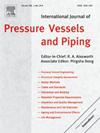提高高V、Ta含量RAFM钢的蠕变性能
IF 3
2区 工程技术
Q2 ENGINEERING, MECHANICAL
International Journal of Pressure Vessels and Piping
Pub Date : 2025-06-06
DOI:10.1016/j.ijpvp.2025.105581
引用次数: 0
摘要
低活化铁素体-马氏体(RAFM)钢是核聚变堆包层的理想材料,其蠕变性能受MX碳氮化物的显著影响。在本研究中,制备了高V (0.27 wt%)和高Ta (0.18 wt%)含量的RAFM钢,促进了大量纳米级MX碳氮化物的形成,命名为9Cr-MX。对9Cr-MX钢进行了650℃、100、120、175、200 MPa和700℃、40、50、60 MPa的蠕变试验。得到蠕变断裂寿命、最小蠕变速率和Larson-Miller参数值。利用扫描电镜(SEM)和透射电镜(TEM)分析了蠕变前后钢板和规范截面的显微组织,包括马氏体板条、M23C6碳化物和MX碳氮化物。结果表明,9Cr-MX钢具有良好的蠕变性能。该钢在700℃、40 MPa条件下的断裂寿命为3566 h,最小蠕变速率为2.83 × 10−9 s−1,LMP值为32.6。这些性能与大量尺寸为35±21 nm、密度为1.73 × 1020 m−3的纳米MX碳氮化物有关。一方面,发现MX碳氮化物阻碍了板条的旋转、聚结和粗化,从而提高了抗蠕变变形能力;另一方面,这些碳氮化物增强了微裂纹的抗蠕变扩展能力,引发微裂纹挠曲。此外,一个有趣的观察结果是,蠕变后MX碳氮化物中的V浓度增加,可能是由于初始的超细尺度层内富V碳氮化物溶解,然后沉淀到先前的富ta碳氮化物上。本文章由计算机程序翻译,如有差异,请以英文原文为准。
Improving creep properties of RAFM steel with high V & Ta
Reduced activation ferritic-martensitic (RAFM) steels are promising candidates for fusion reactor blankets, and their creep properties are significantly influenced by characteristics of MX carbonitrides. In this study, a RAFM steel with high contents of V (0.27 wt%) and Ta (0.18 wt%) was fabricated to promote the formation of numerous nanoscale MX carbonitrides, designated as 9Cr-MX. The 9Cr-MX steel was subjected to creep tests at 650 °C with 100, 120, 175, 200 MPa and 700 °C with 40, 50, 60 MPa. The creep rupture life, minimum creep rate and Larson-Miller parameter (LMP) values were obtained. The microstructure of the steel, including martensitic laths, M23C6 carbides, MX carbonitrides, was characterized utilizing scanning electron microscopy (SEM) and transmission electron microscopy (TEM) in both the tab and gauge sections before and after creep. The results indicated that 9Cr-MX steel exhibited favorable creep properties. The steel achieved a rupture life of 3566 h, a minimum creep rate of 2.83 × 10−9 s−1, an LMP value of 32.6 at 700 °C with 40 MPa. These properties were related to the numerous nanoscale MX carbonitrides with a size of 35 ± 21 nm and a number density of 1.73 × 1020 m−3. On the one hand, MX carbonitrides were found to impede laths rotation, coalescence and coarsening, thereby elevating creep deformation resistance. On the other hand, these carbonitrides enhanced the resistance to propagation of creep microcracks, and triggered microcrack deflection. Besides, an intriguing observation was made of an increase in V concentration within MX carbonitrides after creep, potentially due to the dissolution of initial ultrafine-scale intralath V-rich carbonitrides followed by precipitating onto the pre-existing Ta-rich ones.
求助全文
通过发布文献求助,成功后即可免费获取论文全文。
去求助
来源期刊
CiteScore
5.30
自引率
13.30%
发文量
208
审稿时长
17 months
期刊介绍:
Pressure vessel engineering technology is of importance in many branches of industry. This journal publishes the latest research results and related information on all its associated aspects, with particular emphasis on the structural integrity assessment, maintenance and life extension of pressurised process engineering plants.
The anticipated coverage of the International Journal of Pressure Vessels and Piping ranges from simple mass-produced pressure vessels to large custom-built vessels and tanks. Pressure vessels technology is a developing field, and contributions on the following topics will therefore be welcome:
• Pressure vessel engineering
• Structural integrity assessment
• Design methods
• Codes and standards
• Fabrication and welding
• Materials properties requirements
• Inspection and quality management
• Maintenance and life extension
• Ageing and environmental effects
• Life management
Of particular importance are papers covering aspects of significant practical application which could lead to major improvements in economy, reliability and useful life. While most accepted papers represent the results of original applied research, critical reviews of topical interest by world-leading experts will also appear from time to time.
International Journal of Pressure Vessels and Piping is indispensable reading for engineering professionals involved in the energy, petrochemicals, process plant, transport, aerospace and related industries; for manufacturers of pressure vessels and ancillary equipment; and for academics pursuing research in these areas.

 求助内容:
求助内容: 应助结果提醒方式:
应助结果提醒方式:


